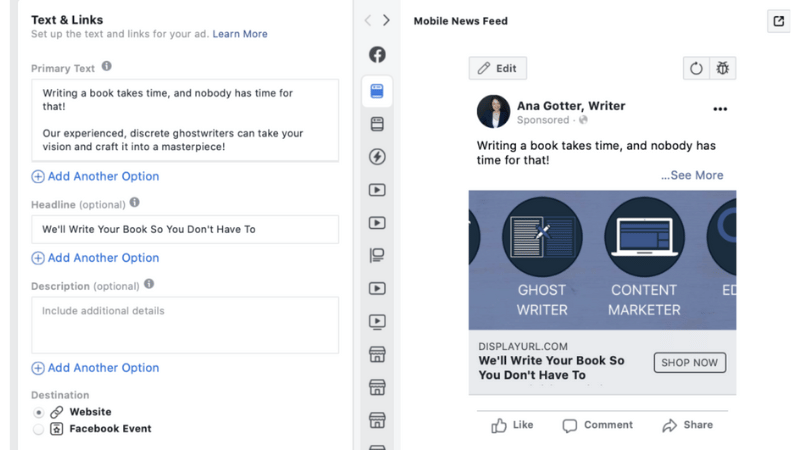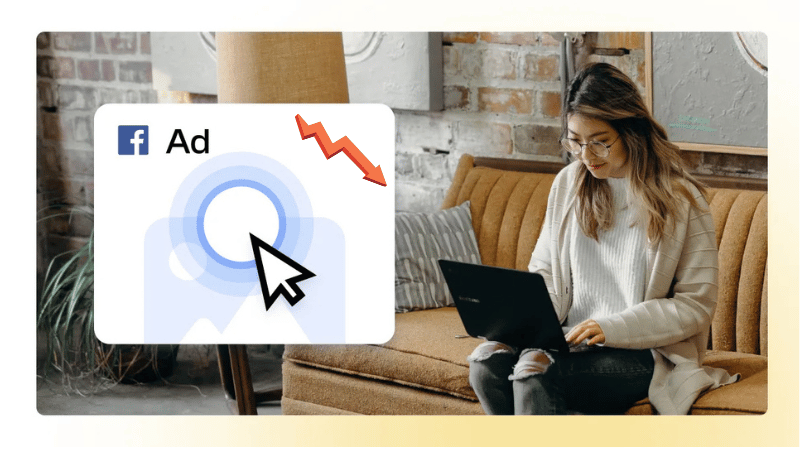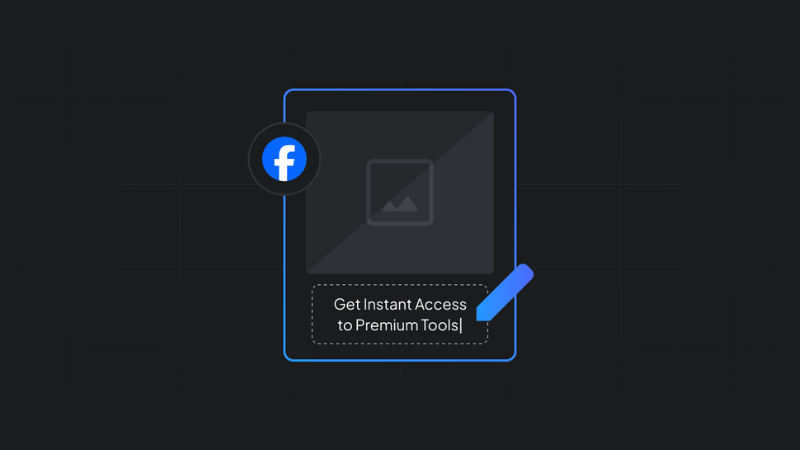You may not realize that a discrepancy of just a few characters in the headline can cause an ad to lose hundreds of clicks? The Facebook ad headline character limit 2025 is not just a technical number; it is the “sweet spot” that helps you grab a viewer’s attention from the very first second. Understanding the Facebook ad headline character limit 2025 will help you write a headline that is short enough not to be truncated, yet engaging enough for users to stop and click. If you are looking to increase CTR and optimize your ad budget, this is a factor you cannot afford to ignore.
Why does headline length determine the success or failure of a Facebook ad?

The headline is the first element users see when scrolling through their news feed, and within those brief seconds, they decide whether to stop or continue scrolling. Therefore, headline length plays a critical role in determining the success or failure of an ad campaign. A concise, clear, and easy-to-read headline not only helps users quickly grasp the ad content but also makes them feel “visually comfortable” and more receptive.
How the Facebook algorithm “reads” and prioritizes concise headlines
The Facebook algorithm operates on the principle of optimizing user experience. The system scans the ad content, determines its relevance, meaning, and headline length to assess the potential for engagement. Short, easy-to-understand headlines containing keywords relevant to user search behavior and interests are often prioritized for display. This not only helps the ad achieve a lower CPM (Cost Per Mille/1000 Impressions) but also increases the chance of being naturally displayed to lookalike audiences.
Facebook also favors direct headlines that offer solutions or clear benefits, such as “50% off your first order” or “Discover the Secret to Healthy, Glowing Skin at Home.” Meanwhile, verbose headlines containing excessive punctuation or vague descriptions are often flagged as confusing, causing the algorithm to reduce the quality score. Therefore, keeping the headline within the 25–40 character range is the optimal choice to ensure clarity and to get “noticed” by the Facebook Ads system.
When does an overly long headline cause CTR to plummet?

An excessively long headline not only fatigues the reader but also risks being truncated by Facebook during display, losing the most crucial part of the message. When users only see half a sentence, they are unlikely to fully grasp the meaning and will almost certainly skip the ad. Especially on mobile devices, which account for over 80% of Facebook traffic, long headlines are even more prone to being cut short, leading to a sharp decline in delivery effectiveness.
Furthermore, a headline exceeding 60 characters often causes the message to lose focus, failing to create a strong enough “emotional touchpoint” for viewers to take action. Actual research from advertisers shows that when a headline exceeds 50 characters, the CTR can drop by 25–30% compared to a more concise headline. Therefore, instead of trying to cram in information, simplify the wording, select keywords, and focus on a single benefit. That is the way to make your Facebook ad headline truly effective, generate a valuable click, and help the campaign achieve maximum performance.
What has changed in the Facebook ad headline character limit 2025?
Before diving into specific elements, let’s look at how the Facebook ad headline character limit 2025 has truly changed and why it is so important. Every year, Meta refines its ad display algorithm to help users access content that is fast, clear, and relevant to their needs.
Latest update from Meta on the headline character limit
Heading into 2025, Meta has made a few small adjustments that significantly impact how ads are displayed on Facebook. In recent updates to Facebook Ads Manager, the system increasingly prioritizes headlines that are short, concise, and allow for “quick scanning”—meaning users can understand the message within a few seconds of scrolling.
According to Meta, the recommended Facebook ad headline character limit 2025 falls between 25–40 characters to ensure full display on both mobile and desktop devices. While the platform still allows inputting up to 255 characters, long headlines are often truncated upon display, especially on mobile phones, which account for over 80% of ad views.
Meta also emphasizes that limiting the length not only helps the system easily optimize content but also contributes to enhancing the user experience. Viewers are no longer overwhelmed by wordy headlines; instead, they see a short, clear, and emotionally evocative sentence.
Furthermore, in the 2025 update, Meta also improved the ad distribution algorithm; creatives with short, clear headlines containing keywords related to the campaign objective are often prioritized for display. This means that understanding the character limit not only helps you avoid truncation errors but also directly affects ad cost and effectiveness.
How many characters to optimize display and engagement?
According to statistics from numerous actual ad campaigns, the ideal focus for a Facebook headline is around 28–32 characters. This is the sweet spot that allows you to fully convey your message while remaining short enough to capture attention in the first few seconds. Facebook users typically scroll very quickly, so only headlines that are immediately “eye-catching” will make them stop. A wordy headline that contains too much information or lacks engaging keywords often causes the Click-Through Rate (CTR) to drop sharply.
For example, instead of writing “Discover the premium shirt collection for the modern office worker,” shorten it to “Office Shirt – Elegant Style Guaranteed!” The second sentence is short, easy to read, and evokes emotion and brand style. Additionally, you should leverage numbers, emojis, or power words such as “50% Off,” “Exclusive,” and “Just Launched” to increase engagement.
How to write a short headline that still makes a strong impression
The Facebook ad headline is the “storefront” of the campaign, determining whether users stop to read or scroll past. However, as the Facebook ad headline character limit 2025 becomes stricter, creating a short headline that still conveys the full message is a real challenge. The secret lies in word choice, semantic arrangement, and tapping into the reader’s emotions. A good headline doesn’t need to be long; it needs to hit the right pain point, target the exact need, and stimulate immediate action.

4 Copywriting formulas for quick, effective short headlines
When you only have a few dozen characters to make an impression, rely on ad industry-proven headline formulas. Below are three key formulas that help you create concise yet high-converting headlines.
Direct benefit formula
This type of headline gets straight to the point, emphasizing the value the customer receives. For example: “20% Off First Order – Claim Yours Today!” or “Stretchy, Comfy Shirt – Confident All Day Long!” This headline creates a sense of “getting a benefit,” immediately drawing the user’s attention. Choose the single most prominent benefit of the product and put it right at the start of the headline—don’t beat around the bush.
Emotional stimulation formula
Readers often react strongly to emotion or mystery. The headline can start with words like “Secret,” “Discover,” “Don’t Miss,” “Today Only,” etc. For example: “The Secret to Choosing the Right Shoe 100% of the Time” or “Discover the Light-as-Air Feel of These New Shoes!” This writing style makes the viewer curious, leading to a sharp increase in CTR.
Scarcity and urgency formula
Emphasizing time or quantity can prompt users to act immediately. For example: “Only 3 Days Left – 50% Off Shoe Sale,” or “Sizes Selling Out Fast – Order Yours Today!” When the Fear Of Missing Out (FOMO) is triggered, the click-through rate will increase significantly without needing an overly long headline.
Number and action combination formula
Numbers create a sense of clarity and reliability. When combined with strong verbs, the headline becomes extremely effective. For example: “3 Steps to Find the Right Bra Size for Every Body Type” or “Top 5 Shirts 90% of Customers Buy Again.” Readers are drawn to specific data, and action is promoted more naturally.
Headline writing mistakes that instantly lower ad score
Many advertisers make the mistake of trying to cram too much information into the headline, making the wording confusing and hard to read. Another common error is the overuse of hyperbolic language like “hot,” “shocking,” or “exclusive,” which Facebook easily flags or makes viewers feel untrustworthy. Additionally, forgetting to insert a brand element or a CTA makes the headline lack impact and fails to drive action.
Remember, a short headline needs a clear objective: pique curiosity, touch an emotion, or drive action. When you balance these three elements, a headline of just a few words is enough to make the reader stop and click. That is the true art of Facebook advertising in 2025.
Combining emojis, numbers, and keywords
A headline containing an emoji or a number often attracts attention 20–30% faster than a purely text-based headline. Use emojis to highlight the emotion or main message, for example: 🔥 “50% Off Today – Limited Stock!” instead of inserting too many, which makes the headline look cluttered. Furthermore, adding specific numbers like “Top 5 secrets” or “Save 30% on costs” helps create a sense of clarity and reliability. Finally, don’t forget to place the main keyword near the beginning of the headline to optimize display and increase relevance within the Facebook algorithm.
How to use A/B testing to select the highest CTR headline
A/B testing is an extremely important method in the Facebook ad optimization process. Instead of relying on intuition, you can create 2–3 different headline versions and test them with the same audience group. After a few days, you will easily see which headline yields a higher click-through rate.
The secret lies in only changing one factor at a time during the test. For example, change the keyword, tone of voice, or add/remove an emoji so that the results accurately reflect the impact of each change. When you have sufficient data, select the headline with the highest CTR and use it as the benchmark for subsequent campaigns. This is how you continuously improve performance without spending additional budget.
Frequently Asked Questions
No. Facebook recognizes all-caps headlines as “spam” or overly promotional content, which can easily reduce the ad quality score. It is best to only capitalize 1–2 important words, for example: “HUGE SALE this weekend – Up to 70% Off.” This way, it retains a natural feel while making the key part stand out more.
The cause stems from user cognitive psychology and how Facebook distributes ads. Two headlines may have the same content, but different structures or keyword order will trigger different emotions. Additionally, Facebook also evaluates the initial engagement rate to prioritize distribution, so just one version being more attractive in the first 1–2 hours is enough to create a noticeable CTR difference.